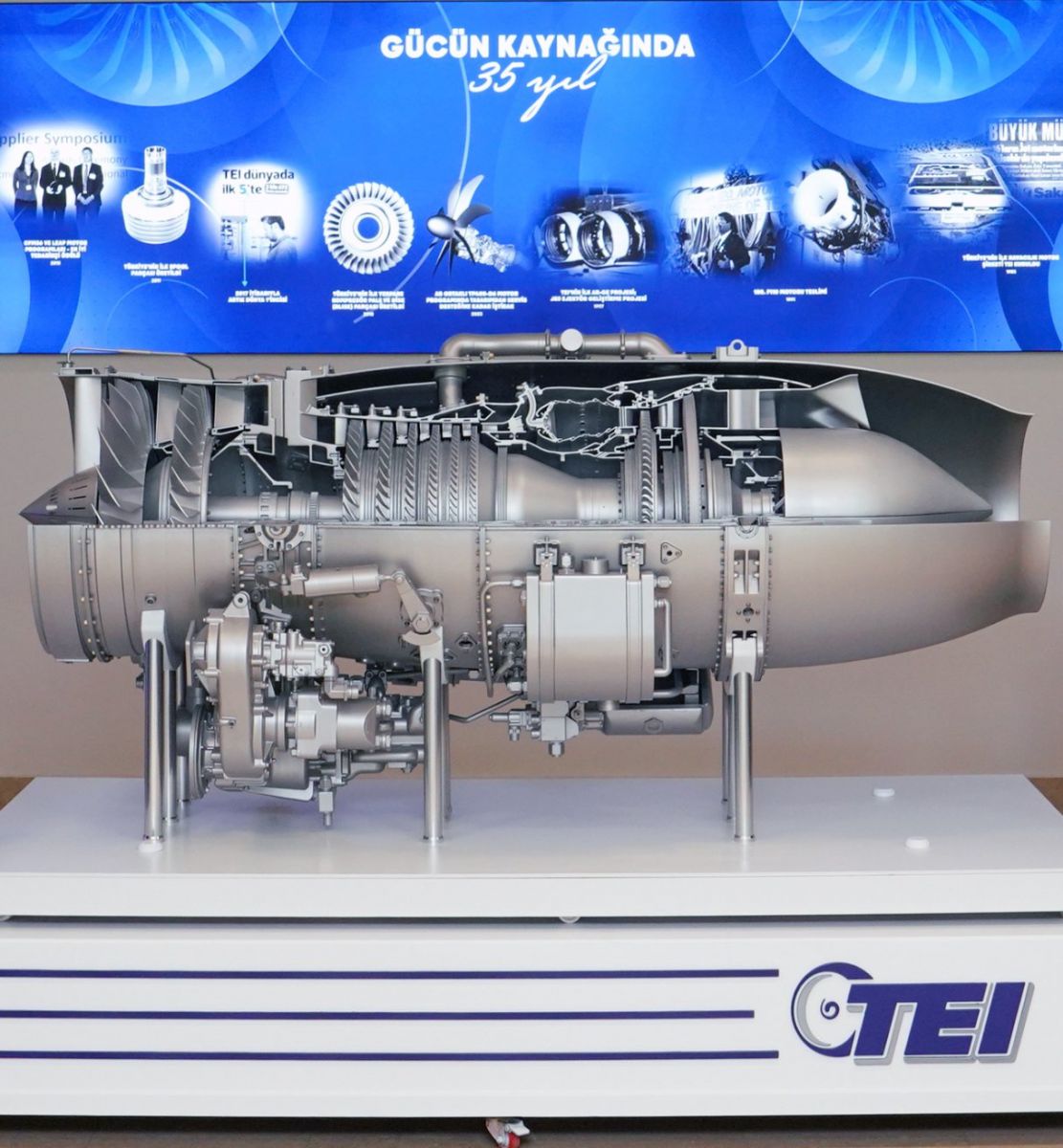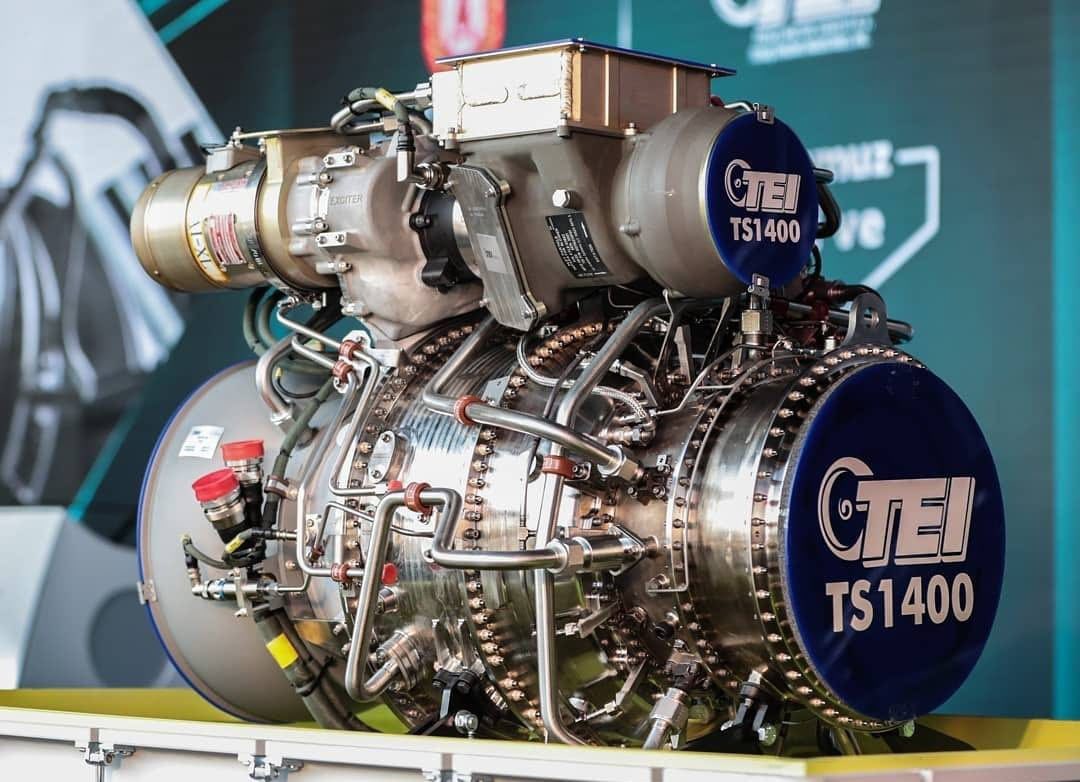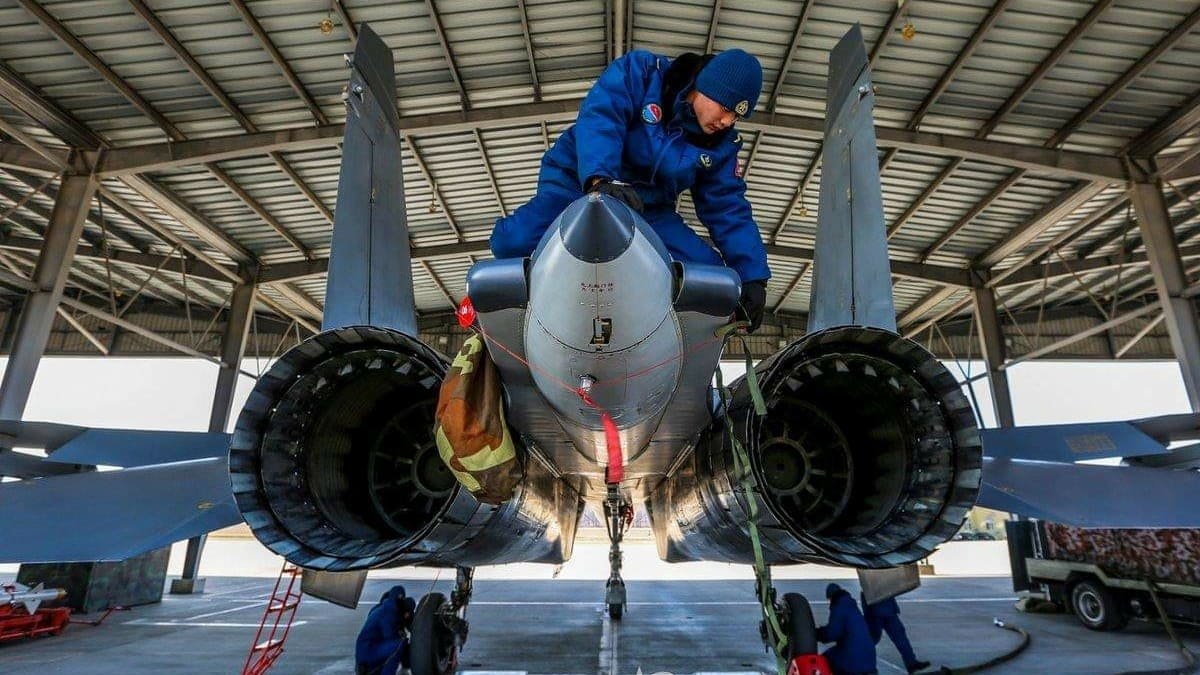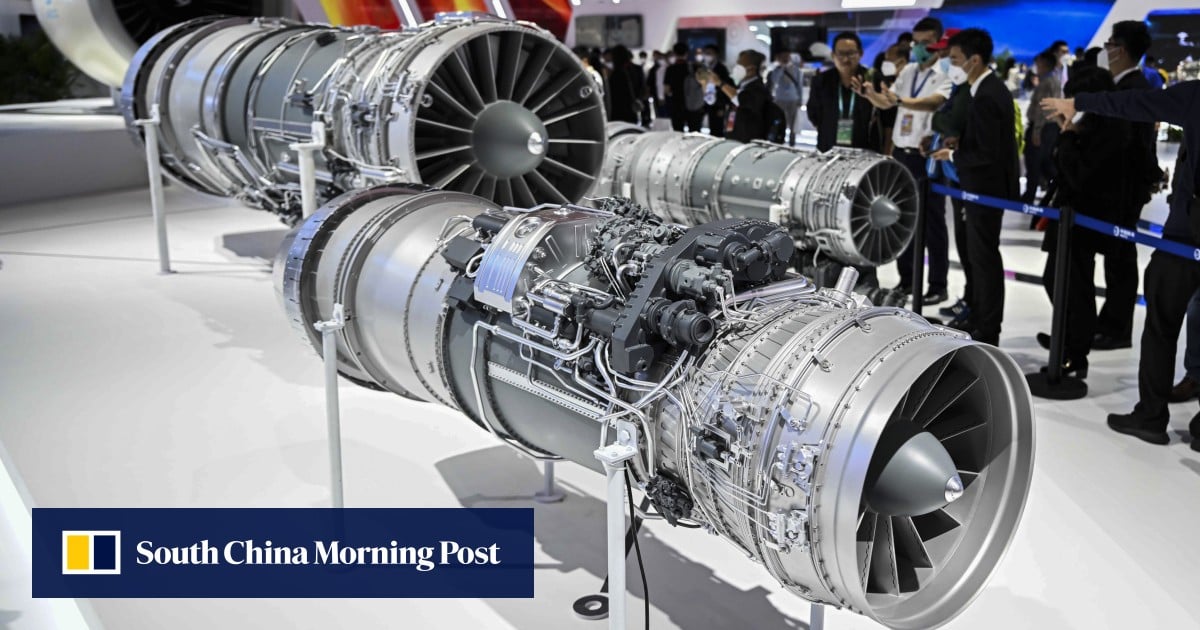
Prototype Manufacturing of Turkey's Most Powerful Engine TEI-TF6000 Started
TEI General Manager Prof. Dr. We present a special interview with Mahmut F. AKŞİT about the TEI-TF6000 Turbofan Engine, which is the largest national turbofan engine developed in our country with a dry thrust capacity of 6,000 lbf, at the Istanbul Air Show 2022 Fair on October 7th.
December 02, 2022
DEFENCE TURKEY: First of all, could you briefly introduce the TEI-TF6000 Turbofan Engine, which was designed in less than two years and came to the prototype production stage and exhibited for the first time at TEKNOFEST Black Sea? What can you say about the compressor and fan design and the number of turbine stages?
prof. Dr. Mahmut F. AKŞİT: Our TEI-TF6000 engine is actually an engine that we, as TEI engineering team, built to train our team on the way to the National Combat Aircraft (MMU/TF-X) and develop it as a talent. We have brought it up to this point with our own means. It is actually the most powerful engine ever designed and developed in Turkey. It gives 6,000 pounds, or 6,000 pounds of thrust. The engine's capacity can actually increase to 10,000 pounds if an afterburner is added to the exhaust section in this state. So it's a pretty powerful engine. Since we have built our engine in terms of technology development, we want to observe the technologies to be used in the engine of the National Combat Aircraft here. We will also use the design analysis software developed by our engineering team to confirm and calibrate the assumptions used in the design.
DEFENCE TURKEY: Kind of like a springboard for the MMU engine...
prof. Dr. Mahmut F. AKŞİT: Yes, in order to confirm and validate the technologies to be used in the big engine there, and then apply it to the big engine...
DEFENCE TURKEY: Isn't TEI one of the three companies that have already bid for the MMU Engine?
prof. Dr. Mahmut F. AKŞİT: As we mentioned before, we, as TEI, are involved in the national development of the engine of the National Combat Aircraft. The engine is essentially a military turbofan engine configuration. There are two fan stages in front, there are compressor stages behind it…
DEFENCE TURKEY: Is there a different fan placement in commercial engines?
prof. Dr. Mahmut F. AKŞİT: Commercial engines have a large single stage fan at the front. A massive fan, the only stage fan we saw getting on the plane. You can even see the light behind it. In commercial turbofans, the actual engine is smaller in the middle. Because the fan is so large, most of the air it produces passes around the engine directly to the rear. In military turbofans, a small part of the air, if not that much, still flows from the outside of the engine, while a significant part of it flows through it to produce the actual power. These are absorbed by the compressor and taken into the combustion chamber, compressed, burned and thrown out from behind. Some of this power is used to spin the fan. Military turbofan engines have a smaller fan diameter. There are different reasons for this. First; You have to go up to high speeds. It is not possible to go higher than the speed of sound with such a big fan. On the contrary, this time it starts to create a disadvantage. As the need for speed increases, the large cross-section creates greater resistance. It is more convenient to use small type fans in military turbofans. In fact, this is what military turbofans are made for. One advantage is of course the afterburner configuration. Throwing some of the air back into the engine as a direct thrust from the outside reduces fuel consumption and increases range. In this way, you fly more economically in military planes on normal flights, except for emergencies. When you press some of the air directly to the back with the fan and mix it with the exhaust, you get a mixture with a relatively higher oxygen ratio at the rear. In emergency and high power situations, in this afterburner, you throw plenty of fuel into the oxygenated air, into the hot exhaust gas, and you get an additional effect with a separate combustion. That's how you get to 10,000 pounds. This is indispensable for military engines when necessary.
DEFENCE TURKEY: You said there are compressor stages behind the fans…
prof. Dr. Mahmut F. AKŞİT: Yes, there is a compressor, but the compressor does not suck all the air blown by the fan, it sucks about half of it in such a configuration.
DEFENCE TURKEY: Are single crystal turbine blades used in TEI-TF6000?
prof. Dr. Mahmut F. AKŞİT: Yes. After burning the air we sucked from the compressor in the combustion chamber, we hit the hot exhaust gas to the turbine blades. And since it directly sees the flame, the hot exhaust gas, those blades must be single crystal turbine blades resistant to very high temperatures so that they can operate at higher temperatures.
DEFENCE TURKEY: So, is the single crystal turbine blade and the IBR used in the F135 TF Engine the same thing?
prof. Dr. Mahmut F. AKŞİT: No, IBR is on the compressor side. On the compressor side, we call the new generation blades blisk (compressor disc and blades produced as a single piece), meaning “bladed disc”. Some other engine manufacturers call it more IBR. Integrally Bladed Rotors (IBR). It actually means the same thing. In other words, the wings are not manufactured separately and stacked on a disc. Disc and wing are integrated, designed and manufactured together.
DEFENCE TURKEY: Does the TEI-TF6000 Engine also have blisk technology?
prof. Dr. Mahmut F. AKŞİT: Yes. Our engine has that new generation blisk or IBR technology. This directly affects the efficiency of the engine.
DEFENCE TURKEY: Dear Akşit, you just mentioned that very high temperatures are reached in the combustion chamber. High temperature means the need for cooling on the one hand and the need for special materials on the other. Are the materials (such as titanium, nickel, steel, aluminum and composite) needed in the TEI-TF6000 Engine Project, especially in the hot region, domestically produced or outsourced? Has the desired level been reached within the scope of aviation engine materials development projects such as CEVHER and KÜÇE, which were previously initiated by SSB and TEI?
prof. Dr. Mahmut F. AKŞİT:As TEI, we saw this need even before our first helicopter engine project started, so we started working with our own means, just like the TEI-TF6000 engine. Of course, it is not possible to expect everything from our state. The state gives many projects. As you already know, the number of projects supported by the SSB has increased significantly. Opportunities are also limited, it is not possible for them to support everything at all times. What are we doing? We start the technologies that we should definitely use beforehand. When it reaches a certain point, we ask for additional support from the SSB and so on. For example, we started the Single Crystal Turbine Blade Casting Process Technology studies before our TEI-TS1400 Turboshaft Engine Development Project. Afterwards, we turned it into an SSB R&D Project, and thanks to their support, we successfully poured it out for the first time in Turkey. Likewise, we started the CEVHER-1 and CEVHER-2 projects, which focus on material technologies. Now, for example, the second phase of ORE-2 begins. Here, too, we carry out R&D projects to produce in Turkey the strategic materials that we are gradually dependent on abroad.
DEFENCE TURKEY: In which parts are Titanium, Aluminum, Steel and Composite materials used in the engine?
prof. Dr. Mahmut F. AKŞİT: Generally, the compressor side on the main flow path at the front is made of Titanium material. Light and relatively cold. The turbine stages after the combustion chamber become Nickel superalloys and are directly exposed to the flame. Unfortunately, titanium cannot work at those high temperatures. In other words, the front side of the engine is usually Titanium, and the rear side is usually Nickel super alloy.
DEFENCE TURKEY: So, are these two materials you mentioned being localized under the CEVHER-1 and CEVHER-2 Projects, which aim to develop materials used in aviation (including the engine) and production processes?
prof. Dr. Mahmut F. AKŞİT: Yes. Of course, they have different grades, there are a thousand and one types. The material developed for wing casting is Nickel super alloy, but it was developed for single crystal. There are also the materials we use for stator nozzles and vanes, for example. They are motionless, do not turn. They are also Nickel super alloy, but they are also made of other materials. As I said, they have different grades. When we say CEVHER-1 and CEVHER-2, we developed the most urgent and indispensable ones in the first stage. Now we have moved to the second stage with ORE-2. In the long term, we are following a strategy that will hopefully produce all the critical materials that our engine needs in our country. Let me give you the good news about alloys. As of now, we have developed the single crystal blade material in Turkey.
DEFENCE TURKEY: Isn't it with TÜBİTAK MAM Materials Institute?
prof. Dr. Mahmut F. AKŞİT: Yes, TÜBİTAK is also involved and we have our subsidiaries (GÜR METAL and Varzene). We have a large materials engineering team in our own R&D Directorate. At the managerial level, we have a Material Process Department of its own. Under their coordination, we developed both single crystal blade material and alloys such as Nickel super alloy “Inconel 718, 718 Plus, 738” in Turkey, together with the TÜBİTAK MAM Materials Institute team and our subsidiaries. But there are more special materials with higher quality, higher strength, such as those used in discs, we are currently working on them.
DEFENCE TURKEY: At what stage are you in the TEI-TF6000 Turbofan Engine Project? Has prototype production started?
prof. Dr. Mahmut F. AKŞİT:Engine design is a cyclical, iterative process. For example, we started the core of our helicopter engine, the TEI-TS1400 Engine, which we manufactured and operated for the first time in Turkey, in November 2017. There are also videos online. That engine, for example, was in the second design cycle. In other words, the engine was designed from the ground up once, then optimized and designed once again. We fabricated and ran that second design. That version, for example, was tested for hundreds of hours, while design iterations continued. Better, better, better. At the moment, we will produce and deliver our first two engines, which we will hopefully approve for manned flight, before the end of this year. Although, TAI says, “Do some tests at TEI before you send it.” he asked us. Therefore, we will do those tests and send the engines like that.
The TEI-TS1400 Engines, which we will give ready for the first manned flight, are in the 8th design cycle, for example. Now coming to the TEI-TF6000 Engine, this engine is still in its early design cycles. In the TEI-TS1400 helicopter engine, for example, we predicted that the second design cycle could now be operated. Of course, with the experience we gained from the helicopter engine, we progressed faster in the design cycles in TEI-TF6000 and took the engine into the prototype manufacturing process within 2.5 years. So the first TF6000 prototype is currently in production.
DEFENCE TURKEY: Can you give a date for the first run?
prof. Dr. Mahmut F. AKŞİT: Especially the first prototype production takes a lot of time in such big engines. Because you write CNC production codes for individual models of all parts. Individual codes are written and sample pieces are tested. Molds are made where necessary. After you see that the software processes everything at the desired size, you can now process real materials. It takes quite a while to do this into hundreds of parts. Engineering it, that is, manufacturing engineering, is also very important here. It normally takes at least two or three years. We are currently trying to fit this into one year.
DEFENCE TURKEY: Will we be able to see a prototype of TEI-TF6000 at IDEF '23 Fair?
prof. Dr. Mahmut F. AKŞİT: We are pressing the team right now, but of course there are also problems with the supply of materials. Supply chains are broken all over the world, especially due to COVID. So think of an engine, there are hundreds and thousands of parts and components on it, big and small.
DEFENCE TURKEY: Can you share a number of parts in the TEI-TF6000 Engine?
prof. Dr. Mahmut F. AKŞİT: The number of main parts that make up the main engine is between 200-300. However, there are many additional things on it, such as more than 1,500 screws, bolts, cables, clips, large and small. But there are between 200 and 300 main parts that make up the body of the actual engine.
DEFENCE TURKEY: At the beginning of our conversation, Mr. Mahmut, you pointed out that the TEI-TF6000 is an engine designed for TEI to train the team and develop it as a talent on the way to the National Combat Aircraft (MMU/TF-X). But the end result will be an engine and it will have a development cost. On which platforms is TEI-TF6000 targeted to be used? For example, the KIZILELMA MIUS platform that comes to mind first?
prof. Dr. Mahmut F. AKŞİT:Let's put it this way, as we have said before for our TEI-TJ300 Turbojet Engine, TEI-TF6000 is also a project to gain experience and know-how. Think about it, we made TEI-TJ300 after TEI-TJ90 Engine. We did it for learning purposes. The TEI-TJ90 was a small engine with a radial compressor. We can almost say that it was our first jet engine. A small engine that powers the ŞİMŞEK High Speed Target Aircraft. TEI-TJ300 is specially designed with axial compressor. The reason is that all these military turbofan engines are axial compressors. TEI-TF6000 also has an axial compressor. We are making a springboard from there by adapting the know-how we developed there to a slightly larger scale. But we pay special attention when choosing the sizes of these intermediate products in order to use them somewhere. Our state has to earn something in return for this effort, right? For example, the TEI-TJ300 has an anti-ship missile engine. MIUS can use the TEI-TF6000 Engine, it is already in its power class, we have chosen it that way. Also, four of these engines can power one of our gunboats. It can also be used as a gas turbine that generates electricity… It produces a power that alone can meet the electricity of approximately 3,000-4,000 homes.

DEFENCE TURKEY: Could you inform us about the latest situation in the TEI-TS1400 Turboshaft Engine Program? Finally, with the use of Alp Aviation gearbox, I guess the rate of locality reached 100%? When is it planned to start on-platform flight tests?
prof. Dr. Mahmut F. AKŞİT: As I have already said in TEI-TS1400, our engines, which we have made into the latest version, are currently in the assembly phase. We will finish assembling them before the end of the year. We already had a year-end goal. We will do some tests that need to be done within the scope of our negotiations with TAI before we deliver them. If nothing goes wrong, we will deliver the engines to them as the end of February next year, with the indispensable tests done. We hope that if they act quickly in the integration of the helicopter, we can get off the ground with our national engine in the first half of next year.
DEFENCE TURKEY: Now, aren't the engines in the 8th design cycle that you're going to give also compatible with the T625's engine bay? After the delivery, the work of adapting the engine mounts on the T625 GÖKBEY Helicopter will not be on the agenda?
prof. Dr. Mahmut F. AKŞİT: Of course. The first prototype we gave at the ceremony attended by our President is almost exactly the same as the last mature version for 'form fit' works, it enters the same place, the connections are the same, everything is the same. That's why we gave it away. We gave it to them as soon as possible so that they could do the formality and integration work early. So, when we give the mature engine that it can fly, they can plug it in and fly it, so to shorten that time. Otherwise, the integration of an engine into an aircraft is a process that takes several years.
DEFENCE TURKEY: Well, this is an engine that never flew after all. When you give it, will it fly directly or will one of the engines be TEI-TS1400 and the other one on the helicopter?
prof. Dr. Mahmut F. AKŞİT: As far as I know, both engines on the helicopter will be TEI-TS1400 in the first flight. Of course, TAI will decide this. But first, they tie the helicopter on the ground and force it as if it was at full power. They do all the tests, if there is no problem, they untie the chains, then they do the tests at 10-15 meters above the ground. Therefore, they do not suddenly lift the helicopter and take it to the sky.
DEFENCE TURKEY: A similar process was followed in the first flight of the T625 GÖKBEY helicopter.
prof. Dr. Mahmut F. AKŞİT: Yes, we say “hover” a little above the ground. We expect the same here. In other words, if we pass the maximum tests on the ground without any problems towards the middle of next year, I hope we will see the helicopter take off from the ground.
Source :
https://www.defenceturkey.com/tr/ic...f6000-motorunun-prototip-imalati-basladi-5308














